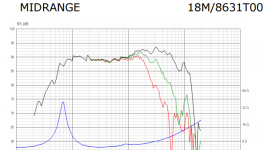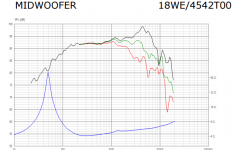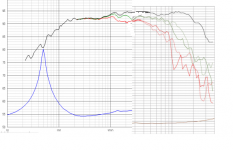Of yourse it's fast, it's got no real bass.
Yup, no bass.It needs a woofer.
What's the benefit of an elliptical voice coil?
Can't really think of any.
Sure, the distance from voicecoil to cone edge varies a little, but it looks like a fractional difference, so all that'll do is de-Q the cone breakup a little.
The manufacturer claims these drivers have low distortion, but that could easily be down to the copper sleeve on the polepiece.
Chris
Did manufacturer specify what kind of distortion was supposedly improved, linear or non-linear?
One more thing came to my mind (it is just an educated guess...).
Is it possible, that an elliptical shaped voice coil is more resistant against torsional (twisting) deformation? I am thinking on twisting perpendicular to the horizontal plane of the voice coil. That is an often overlooked -but real- source of distortion in drivers.
Is it possible, that an elliptical shaped voice coil is more resistant against torsional (twisting) deformation? I am thinking on twisting perpendicular to the horizontal plane of the voice coil. That is an often overlooked -but real- source of distortion in drivers.
Is it possible, that an elliptical shaped voice coil is more resistant against torsional (twisting) deformation? I am thinking on twisting perpendicular to the horizontal plane of the voice coil. That is an often overlooked -but real- source of distortion in drivers.
No, that's not the case, rather the opposite. An oval shaped object is always weaker in one direction. And an oval voice coil crashes sooner the pole plate than a round one because of the greater angle. You are confusing cause and effect because the spider leads the VC, not the other way around. That means it's not a problem with the VC, that's a problem of the suspension (surround, spider) at great excursions, heat often increases the problem.
I suspect an elliptical coil is substantially more prone to misalignment requiring higher precision during assembly raising costs.
There are a lot of benefits. The most important one is the higher tonal complexity, because every VC diameter has its distinctive tonal signature. 18WE uses very smart combination of 35mm size (having better transient behavior than 40mm VC) and 45mm (having much tonally dense sound again compared to round 40mm VC). 40mm is the optimal diameter for lower midrange reproduction, but only speaker driver constructors with a lot of experience in the field and with Ears in their head could understand why.What's the benefit of an elliptical voice coil?
Second most important benefit is the lower phase angle of impedance, because with oval profile there is more resistance for a given inductance or if you prefer - lower inductance for a given resistance.
There are a lot of benefits. The most important one is the higher tonal complexity, because every VC diameter has its distinctive tonal signature. 18WE uses very smart combination of 35mm size (having better transient behavior than 40mm VC) and 45mm (having much tonally dense sound again compared to round 40mm VC). 40mm is the optimal diameter for lower midrange reproduction, but only speaker driver constructors with a lot of experience in the field and with Ears in their head could understand why.
Second most important benefit is the lower phase angle of impedance, because with oval profile there is more resistance for a given inductance or if you prefer - lower inductance for a given resistance.
So let me guess again. Then you must be one of those " speaker driver constructors with a lot of experience in the field and with Ears in their head".
The second part I could not make it clear even after severeal readings, how is that about "lower phase angle of impedance"?
There are a lot of benefits. The most important one is the higher tonal complexity, because every VC diameter has its distinctive tonal signature. 18WE uses very smart combination of 35mm size (having better transient behavior than 40mm VC) and 45mm (having much tonally dense sound again compared to round 40mm VC). 40mm is the optimal diameter for lower midrange reproduction, but only speaker driver constructors with a lot of experience in the field and with Ears in their head could understand why.
Oh, is that so? Well, I guess I need one driver for rock, one for jazz, one for classic.. But, if having 45mm in one direction and 35mm in the other, doesn't that mean, the speaker is always half in the wrong?
Second most important benefit is the lower phase angle of impedance, because with oval profile there is more resistance for a given inductance or if you prefer - lower inductance for a given resistance.
But inductance is needed for the movement. Less inductance is then less motor but I always thought that was bad. 😕
But inductance is needed for the movement. Less inductance is then less motor but I always thought that was bad. 😕[/QUOTE]
Nope. Electromagnetic force is the result of a current flowing through a magnetic field in a given length of wire.
F=BxIxl, where B is the magnetic field strength, I is the current , and l is the length of the wire.
L (inductance) has not much to do with it, tough there is a connection between these factors (longer wire means more turns needed on a coil, and that results in higher inductance).
You can increase F in a relatively smaller inductance (shorter wire) coil by increasing the current, and (or) the strength of the magnet.
Nope. Electromagnetic force is the result of a current flowing through a magnetic field in a given length of wire.
F=BxIxl, where B is the magnetic field strength, I is the current , and l is the length of the wire.
L (inductance) has not much to do with it, tough there is a connection between these factors (longer wire means more turns needed on a coil, and that results in higher inductance).
You can increase F in a relatively smaller inductance (shorter wire) coil by increasing the current, and (or) the strength of the magnet.
Last edited:
Nope, I'm just a deaf Audio-Moron, who is listening to his laughable drivers with ironless motors, oval voice coils and Kurt Muller cones with complex shapes 😉So let me guess again. Then you must be one of those " speaker driver constructors with a lot of experience in the field and with Ears in their head".
The closest to you experienced constructor is Istvan in Hungary.
Is there anything else you want to guess.
There are a lot of benefits. The most important one is the higher tonal complexity, because every VC diameter has its distinctive tonal signature. 18WE uses very smart combination of 35mm size (having better transient behavior than 40mm VC) and 45mm (having much tonally dense sound again compared to round 40mm VC). 40mm is the optimal diameter for lower midrange reproduction, but only speaker driver constructors with a lot of experience in the field and with Ears in their head could understand why.
Second most important benefit is the lower phase angle of impedance, because with oval profile there is more resistance for a given inductance or if you prefer - lower inductance for a given resistance.
Bollocks.
Nope. Electromagnetic force is the result of a current flowing through a magnetic field in a given length of wire.
Shh! I know. But he doesn't. 😉
Nope, I'm just a deaf Audio-Moron, who is listening to his laughable drivers with ironless motors, oval voice coils and Kurt Muller cones with complex shapes 😉
The closest to you experienced constructor is Istvan in Hungary.
Is there anything else you want to guess.
Oh come oooon! What is this outrage for? Did I hurt your ego that much? Sorry if I did so... I have not much experience myself, only 11 years at Totem as chief designer, and another 30 in the field of driver and speaker system design and construction. But then I guess (again) you have much more than this.....
As i alvays pay more attention to the response of a driver at 30º than the classical 0º on axis one, i must say that the more i see the curves of the new alienoid esoteric creature given birth by SS, the more i like them...
Compared to the 18W revelator midwoofer, and even to the recent 18M midranger, i see a clear improvement in the new 18WE 30º response...😱
PD: though i'm also out of my mind, i know...
Compared to the 18W revelator midwoofer, and even to the recent 18M midranger, i see a clear improvement in the new 18WE 30º response...😱
PD: though i'm also out of my mind, i know...

Attachments
As i alvays pay more attention to the response of a driver at 30º than the classical 0º on axis one, i must say that the more i see the curves of the new alienoid esoteric creature given birth by SS, the more i like them...
Compared to the 18W revelator midwoofer, and even to the recent 18M midranger, i see a clear improvement in the new 18WE 30º response...:eek
You do? I can't see there anything improved. Ofcourse the angle response is important. But you forgot a. you can't just take one curve and say "that's it, how wonderful", that's exactly the same mistake as just only taking the 0° response. And b. the response above the used range can't be ignored because it's not magically disappearing, you have to deal with it in the crossover. And if you take that into account, you'll realize the revelators are much more linear, they don't introduce any peaks above the used range, they just fall of nicely and uneventful. That makes them so much easier to handle.
- Home
- Loudspeakers
- Multi-Way
- Scan-Speak has a new line: The Ellipticor




